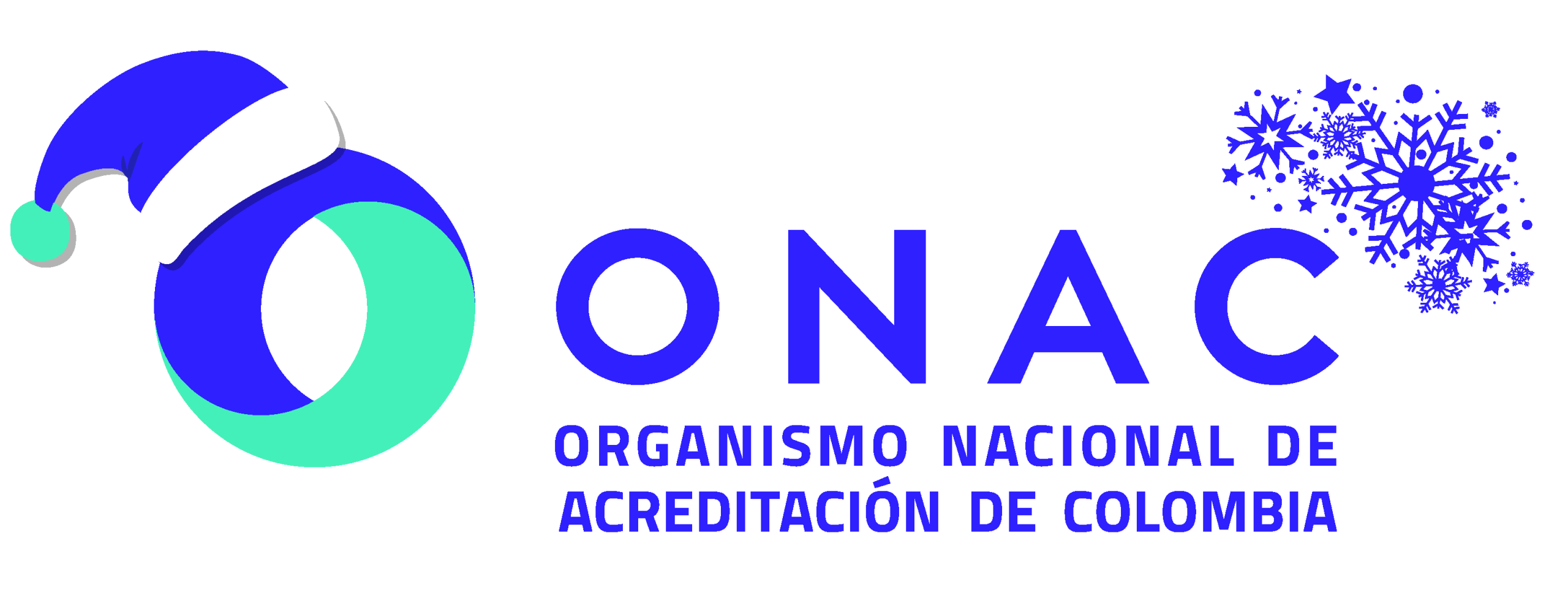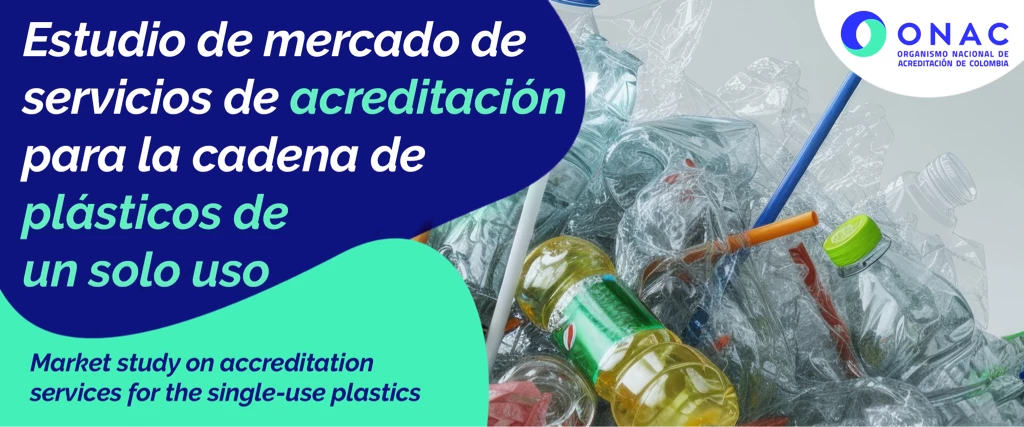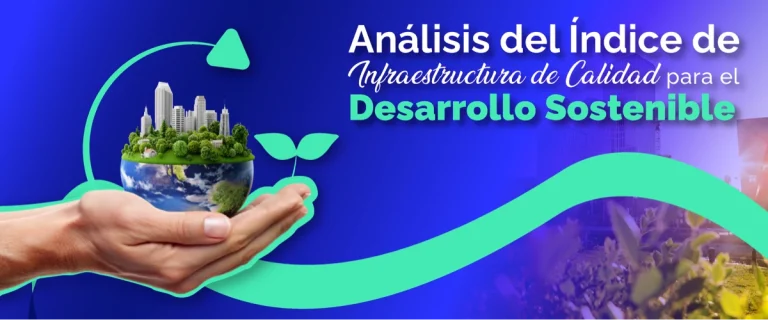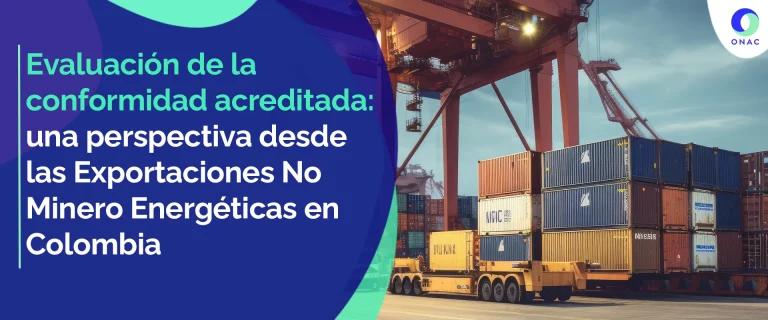Economic and Social Research Coordination for Quality Infrastructure
Organismo Nacional de Acreditación de Colombia – ONAC
Abstract
This document analyzes the market for accreditation services in the Colombian Technical Standard 6632:2022 “Plastics. Recycled plastics. Traceability and conformity assessment of plastic recycled and recycled content”. Simultaneously, it analyzes the possible standards that could be applied to the assessment of biodegradability and compostability of single-use plastics under natural environmental conditions.
Background
The updating of the regulations applicable to plastic products has prompted important changes in the requirements to be met by these products. In this regard, regulatory frameworks have specified the requirements that single-use plastics must meet to be allowed to circulate in the market. One of these requirements is the development of tests and evaluations to verify the conditions of the plastics produced and marketed, which must be carried out by accredited Conformity Assessment Bodies (CABs). In this context, the need arises to develop this study in order to determine the current status of CABs in this area and to determine the process that should be followed in order to include the necessary accreditation services in ONAC´s portfolio of services.
Objective
The objective of this document is to conduct a market study of accreditation services in the standards applicable to the single-use plastics chain.
Scope
This document presents the particularities of the plastic sector and the market of certification and accreditation services in the standards applicable to the single-use plastics chain. It also reviews the regulatory frameworks that determine the requirements that plastic products must meet in order to circulate in the market.
1. Introduction
Plastic has become one of the most used materials in different industries due to its low cost, versatility and ease of use. This material offers numerous benefits for companies, consumers and society in general. Among its advantages are the reduction of greenhouse gas emissions (as it is lightweight and easy to transport), the significant extension of the shelf life of fresh food and beverages, and the reduction of waste and wasteful use of resources. In addition, plastics play a crucial role in the healthcare sector by facilitating the production of medical devices and supplies that are economical and effective.
However, despite these benefits, plastics serious environmental impacts, which is why, in recent years, governments and consumers have become more environmentally conscious, which in turn has increased the demand for more sustainable materials with less impact on the environment. As a result, there has been a push from regulatory frameworks to reduce the consumption of single-use plastic products, increase and encourage the recycling and subsequent use of plastic waste, as well as increase the demand for biodegradable and compostable plastics.
In this regard, Colombia issued Law 2232 of 2022, which will gradually prohibit single-use plastic products, as well as it specifies the exceptions for their production and distribution. This regulation has stablished certain requirements that single-use plastics must comply with in order to be marketed and used in the country, such as demonstrating compliance with the requirements of biodegradability or certifying that their products are manufactured from 100% recycled plastic material from domestic post-consumption. For such certification, producers must go to a CAB accredited by ONAC under the Product Certification scheme. Thus, this study first analyzes the economic context of the plastics sector in the country, then it reviews the regulations applicable to the sector, finally it analyzes the potential market of accredited CABs that could meet demand for certification services. As a conclusion, the main findings are discussed.
2. Context of the plastics sector
In 2023, the plastics industry in Colombia consumed more than one million metric tons of polymers. The high demand for raw material translates into a significant production distributed among several sub-sectors, showing the importance and scope of the plastic industry in the Colombian economy.
Distribution of the production
- Containers and packaging (56%): This sub-sector accounts for the majority of plastic production in Colombia. The customization capacity and versatility of plastics in the design of containers and packaging make them indispensable for the food and beverage industry, as well as for other massive consumption goods.
- Building materials (22%): Plastic products are widely used in construction due to their properties such as durability, corrosion resistance and ease of installation. These materials include pipes, insulation and coatings, which are essential for modern infrastructure.
- Agricultural sector (9%): In agriculture, plastics are used for irrigation systems, greenhouses and packaging of agricultural products, improving efficiency and reducing waste of resources.
- Other industrial and consumption uses (13%): This segment includes a variety of industrial applications and consumer products such as household appliances, automotive components, and everyday items, reflecting the omnipresence of plastic in various facets of modern life.
Diversification in plastics production not only reflects the versatility of the material, but also its crucial role in the economy. The industry´s ability to adapt to different industrial and consumer applications ensures that it plays a key role in the country´s economy. Ain addition, the plastics industry generates approximately 200.000 direct jobs, which represents an important part of the workforce in the manufacturing and service sectors. Investments in modernization and expansion, which grew 29% in 2023, reflects continued confidence in the sector and its ability to innovate and improve efficiency.
The following sub-sections will analyze the behavior of different key variables for the plastics sector in Colombia.
2.1. Production of plastics in Colombia
Colombian plastics market is driven by the country´s population growth and urbanization in the country, which are contributing to the increase in demand for plastic products, particularly for packaging, construction materials and consumer goods. In addition, the availability of raw materials such as polyethylene and polypropylene, as well as skilled labor, is helping to drive the growth of the plastics industry in Colombia. Graph 1 shows the variation of plastics production in recent years, highlighting the decline and recovery due to the pandemic, as well as the 4% drop in 2023.
Graph 1 Change in nominal production index for plastic products*
Source: Monthly Manufacturing Survey with a Territorial Focus (EMMET) – DANE. Calculations by Economic and Social Research Coordination for Quality Infrastructure – ONAC.
According to the latest data from the Annual Manufacturing Survey, in 2022 the manufacturing industry had a gross production of COP 421 billion. Of this grand total, rubber and plastics products accounted for COP19.3 billion, or approximately 5%.
When disaggregating the production of plastics and rubber, it can be observed that plastics had a gross production of 15.1 billion, i.e., they contributed 4.6% to national industrial production.8
2.2. Trade balance, imports and exports of plastic products
It is also important to analyze whether the production is destined for domestic consumption or for export. Graph 2 shows the behavior of imports and exports of plastic products based on the value exported and imported each year. From the graph it is possible to determine that the trade balance is negative, i.e., imports exceed exports, which implies that the country demands a large amount of plastics from abroad.
Graph 2 Value of imports and exports of plastic products
(millions of US dollars)
Source: Ministry of Trade, Industry and Tourism. Calculations by Economic and Social Research Coordination for Quality Infrastructure – ONAC.
Exports have grown by an average of 7% in the last 5 years. Table 1 shows the main countries to which plastic products were exported from Colombia in 2023. In the first place is the United States, the main destination for plastic exports, followed by Central America and the Caribbean and Ecuador.
Likewise, it is important to mention that plastic exports were highly concentrated in polymers of propylene or other olefins in primary forms, These materials are low-cost, resistant to moisture, chemicals and temperature changes, and are therefore used in a wide variety of industries and environments.
Table 1 Destiny of Colombian plastic products exports in 2023
Country | FOB exports value (in dollars) | Quantity exported (in kilograms) |
United States | 155.839.359 | 30.164.296 |
Central America and the Caribbean | 107.026.604 | 22.274.750 |
Ecuador | 86.429.919 | 19.731.860 |
Mexico | 77.073.189 | 16.808.288 |
Peru | 46.925.832 | 9.544.935 |
Chile | 44.241.568 | 8.106.334 |
Venezuela | 35.900.464 | 10.414.144 |
European Union | 31.144.990 | 6.310.712 |
Brasil | 25.089.412 | 5.439.671 |
Panama | 22.681.491 | 4.891.305 |
Argentina | 11.064.803 | 2.021.313 |
Puerto Rico | 9.651.251 | 1.922.063 |
Source: Ministry of Trade, Industry and Tourism. Calculations by Economic and Social Research Coordination for Quality Infrastructure – ONAC.
On the other hand, table 2 shows the place of origin of plastic products imports. Colombia acquires mostly plastics from China, European Union countries and the United States.
Table 2 Place of origin of plastic products imports to Colombia in 2023
Country | FOB imports value (in dollars) | Quantity imported (in kilograms) |
China | 409.177.192 | 227.668.993 |
European Union | 158.658.464 | 18.966.556 |
United States | 157.728.812 | 12.779.193 |
Brasil | 82.600.941 | 15.787.876 |
Mexico | 55.035.558 | 10.125.640 |
Peru | 42.066.634 | 14.481.297 |
Ecuador | 24.004.447 | 9.763.599 |
Chile | 15.871.190 | 4.308.379 |
Japan | 9.999.009 | 336.835 |
Canada | 6.794.280 | 876.984 |
Argentina | 6.415.540 | 882.281 |
Central America and the Caribbean | 6.311.093 | 1.927.872 |
Source: Ministry of Trade, Industry and Tourism. Calculations by Economic and Social Research Coordination for Quality Infrastructure – ONAC.
2.3. Sales of plastic products within the country
With regard to sales of plastic products in Colombia, graph 3 shows the sector´s performance, with an 8% drop by 2023. Nevertheless, the sector is emerging as one of the most dynamic and with the greatest potential to develop investment opportunities through new projects, strategic alliances or acquisitions, due to the sector´s potential to participate in different value chains of other industries. 12
Graph 3 Variation of real sales of plastic products in the country 13
Source: Monthly Manufacturing Survey with a Territorial Focus (EMMET) – DANE. Calculations by Economic and Social Research Coordination for Quality Infrastructure – ONAC.
2.4. Plastics sector as an employment generator
Considering that the plastics sector supplies different value chains with its products, it is worth analyzing its performance in terms of employment generation. In this sense, the plastics sector is a great mobilizer of employment in the country. To determine its impact on the labor market, data from the Monthly Manufacturing Survey with Territorial Focus (EMMET for its name in Spanish) are used, particularly the employed personnel index. This variable includes the average number of people performing paid work in the sector’s establishments. The behavior of this index in the 2019-2023 period is shown below. As it can be seen, from 2021 the variation of employed personnel in the sector has been positive although it has slowed down in 1% for 2023.
Graph 3 Variation of the employed personnel index in the plastics sector in Colombia 14
Source: Monthly Manufacturing Survey with a Territorial Focus (EMMET) – DANE. Calculations by Economic and Social Research Coordination for Quality Infrastructure – ONAC.
According to Acolplásticos, 15 with data from the Annual Manufacturing Survey (EAM) and the Large Integrated Household Survey (GEIH), in 2022 the manufacturing industry occupied 2.343.551 people out of the 22.468.000 occupied in the country. 16 Likewise, among those employed in the manufacturing industry, plastics in primary forms and plastic products employed 198.967 people, that is, 8.5% of those employed in the manufacturing industry.
Table 3 shows the distribution of employed people in different industrial clusters included in the manufacturing industry. It is possible to see that, between the segments listed in the table, plastic products is the one with most people employed.
Table 3 People employed in some of the sectors of the manufacturing industry in 2022 17
|
Industrial clusters |
Number of employed people |
|
Textile preparation and weaving |
43.121 |
|
Textile products, except apparel |
61.401 |
|
Footwear |
32.107 |
|
Basic chemicals |
36.091 |
|
Substances and basic chemicals |
18.514 |
|
Plastics in primary forms |
7.499 |
|
Other chemicals |
156.549 |
|
Paints, varnishes and similar coatings, printing inks and mastics |
19.217 |
|
Other chemical products n.e.c. |
20.858 |
|
Rubber products |
16.874 |
|
Plastic products |
191.468 |
|
Total manufacturing industry |
2.343.551 |
Source: Acoplásticos. Calculations by Economic and Social Research Coordination for Quality Infrastructure – ONAC.
2.5. Establishments engaged in the production of plastic products and plastics in primary forms.
The manufacturing industry in Colombia encompasses a wide variety of sectors, among which the production of plastic products and plastics in primary forms, play a crucial role. As of June 2023, data on industrial establishments provides a clear view of the distribution and size of these establishments, highlighting the importance of micro and small enterprises in this sector.
Table 4 Number of establishments in the plastics sector with respect to the manufacturing industry at the end of June 2023. 18
|
Industrial cluster |
Microenterprises |
Small |
Medium |
Big |
Total |
|
Plastics in primary forms |
337 |
80 |
20 |
7 |
444 |
|
Plastic products |
2.012 |
661 |
239 |
65 |
2.977 |
|
Total manufacturing industry |
137.081 |
10.040 |
2.596 |
822 |
150.539 |
Source: Acoplásticos. Calculations by Economic and Social Research Coordination for Quality Infrastructure – ONAC.
Table 4 reveals that the establishments engaged in plastic production constitute a significant part of the total number of establishments in the manufacturing industry, with 2.977 units. Of these, a large majority are micro companies (2.012) followed by small companies (661), medium companies (239) and large companies (65). Meanwhile, the production of plastics in primary forms is also distributed in different sizes of establishments, with a total of 444 units. Of these, micro companies represent the majority (337), followed by small companies (80), medium companies (20) and large companies (7).
Thus, establishments dedicated to plastic products in Colombia represent about 2% of the establishments in the manufacturing sector in the country.
3. Regulation applicable to the plastics sector
Plastics production and use can have potential impacts on the environment, according to the United Nations Environment Programme (UNEP), each year, more than 280 million tons of short-lived plastic products end up in the trash. In total, 46% of plastic waste is deposited in landfills, while 22% is improperly managed and becomes litter. This situation worrying considering that plastic, for its impermeability, takes many years to biodegrade and can take hundreds of years to decompose. For this reason, when plastic is discarded, it accumulates in the environment generating levels of contamination that suffocate marine fauna, deteriorate the soil, poison groundwater and can cause serious consequences for human health. 19
In Colombia, regulations have been aimed at encouraging the proper management of plastic waste, mainly single-use plastics. In this sense, there are a series of rules that determine the conditions in which plastics should be processed and the conditions that consumers and producers of single-use plastics must guarantee in order to favor the circular economy and the maximum use of these elements. To this end, among other documents, the National Government issued:
3.1. Law 2232 of 2022
“Whereby measures are established for the gradual reduction of the production and consumption of certain single-use plastic products and other provisions are enacted”. This law establishes measures aimed at reducing the production and consumption of single-use plastics in the national territory, dictates provisions that allow their gradual replacement by sustainable alternatives and their closing of cycles, and establishes complementary measures.
Among the provisions of the document, one of the most relevant is the prohibition of the introduction into the market, marketing and distribution in the national territory of the following products manufactured, totally or partially, with single-use plastics, including those produced with oxo-degradable plastics:
- Checkpoint bags used for packaging, loading or transporting packages and goods, except those reusable or for industrial use.
- Bags used to pack newspapers, magazines, advertising and invoices, as well as those used in laundries to pack washed clothes.
- Rolls of empty bags in commercial surfaces for packing, loading or transporting packages and goods or carrying food in bulk, except for products of raw animal origin.
- Containers or packages, containers and bags to contain non-prepackaged liquids, for immediate consumption, to take away or for home delivery.
- Plates, trays, knives, forks, spoons, glasses and eating gloves.
- Drink mixers and straws.
- Plastic supports for inflation pumps.
- Confetti, tablecloths and streamers.
- Containers or packages and containers to contain or carry meals or food not prepackaged in accordance with current regulations, for immediate consumption, used for take-out or home delivery.
- Sheets for serving, packaging, wrapping or separating food for immediate consumption, used for take-away or home delivery.
- Plastic cotton swab holders or flexible swabs with cotton tips.
- Floss handles or single-use dental floss holders.
- Packaging, containers or any container used for the marketing, to the final consumer, of fresh fruits, vegetables and tubers that in their natural state have peels; fresh aromatic herbs, fresh vegetables and fresh mushrooms. Such packaging, containers or receptacles may be used to ensure food safety, prevent food loss or waste, and/or protect the integrity of the food against damage, provided that the materials used are fully recyclable and/or recycled, as permitted by health regulations, and have goals of reincorporation in a circular economy model.
- Stickers, labels or any distinctive markings affixed to the plants.
However, this prohibition has a series of exceptions under which it may be possible to use the aforementioned elements. Some of them are listed below:
- Action 100 and Action 110: (applicable to the products in the list with the exception of those contained in items 1, 2, 3, 6, 7 and 11)
Action 100 is that single-use plastics may be placed on the market, marketed or distributed if, within the framework of an Extended Producer Responsibility and Circular Economy scheme, at least 100% of the plastic placed on the market of its own type of product, or of a product made with the same polymer or polymer blend of its product, is recovered and used.
Action 110 is that they recover and utilize at least 50% of the plastic placed on the market from their own product type, or from a product made with the same polymer or polymer blend as their product; and additionally, they recover the remaining amount to reach at least 110% of the total single-use plastic placed by them in the market, with other plastic products, as long as they are not PET bottles of treated drinking water, PET bottles with other types of beverages, bottles, containers and containers made with high density polyethylene, plastics used in the construction sector to protect doors, glass, tiles and bathroom fixtures.
- Biodegradability and/or composability in natural environmental conditions:
For the exception to be applicable, the producer must demonstrate that the single-use plastic products are biodegradable and/or compostable under natural environmental conditions, for which the National Government will issue the technical standards regarding the conditions that must be met.
As a reference point, the law takes into account a biodegradation and/or composting ratio of 50% in 3 years and 85% in 4 years counted from the final disposal of the product in natural environmental conditions. However, the biodegradation result must not contain substances such as Zinc, Nickel, Copper, Cadmium, Lead, Mercury, Chromium, Arsenic or Cobalt in its composition.
To demonstrate the completeness of compliance with the requirements, the law establishes that producers must have access to laboratories accredited by the National Accreditation Body of Colombia (ONAC) to verify compliance with the established requirements and technical standards. Article 34, paragraph 2 of the Law mentions that:
The national government, through the National Accreditation Body of Colombia (ONAC), shall be responsible for accrediting national and international laboratories that have the capacity to verify compliance with the provisions of the first paragraph and the technical standards set forth in the second paragraph of this article.21
3.2. Resolution 0803 (June 24, 2024) “By which the provisions of Law 2232 of 2022, on the gradual reduction of the production and consumption of certain single-use plastic products, Article 2.2.7C.7 of Decree 1076 of 2015 establishing measures aimed at the gradual reduction of the production and consumption of certain single-use plastics and adopting other provisions are partially developed.” 22
Subsequently, the Ministry of Environment and Sustainable Development issued this resolution establishing a series of requirements around the production and use of single-use plastics. Among these provisions is, for example, the need to implement Extended Producer Responsibility (EPR) for waste single-use plastic products. This must be carried out through a series of environmental management and control instruments, including third party conformity assessment instruments where applicable.
It is also established that the producers of plastic containers and packaging and single-use plastic products must meet the collection, recovery and recycled raw material content targets in the new product, with respect to the total weight placed by them on the market in the base year. The targets specified in the Resolution can be consulted in Annex 1. In this context, the resolution requires compliance with certain general technical requirements to verify the minimum content of recycled raw material in the new product (as a way of monitoring compliance with the targets set).
Thus, the producer must go to a Conformity Assessment Body (CAB) to ensure the accuracy and transparency of the information through an objective assessment and the issuance of a third party certificate under the requirements of NTC 6632:2022 “Traceability and conformity assessment of plastic recycling and recycled content”. The OEC in charge of making the evaluation must be accredited by ONAC (or by an accreditation body member signatory of MLA and IAF) in the scheme of Product, Process and Service Certification under the technical standard ISO/IEC 17065.
On the other hand, the resolution takes up some of the requirements established in Law 2232 of 2022, among them, it specifies that all single-use plastic products that present third party certification, issued by accredited CABs, demonstrating that their products are manufactured with 100% recycled plastic raw material from domestic post-consumer material, will be exempted from the prohibition.
Likewise, CABs must express in their scope of accreditation the standard NTC 6632:2022 “Traceability and conformity assessment of plastics recycling and recycled content”, and third party certificates issued by accredited OECs must be issued using the type 6 scheme, for process certification, related to ISO/IEC 17067:2013.
Regarding the biodegradability and/or composting requirements under natural environmental conditions established in Law 2232 of 2022, the resolution specifies that producers must submit the verification results of the percentage of biodegradation and/or composting of single-use plastic products under natural environmental conditions and demonstrating the absence of substances of concern in the biodegradation results of the laboratory test, as well as the nationally or internationally accredited test methods for such purposes. These results must be issued by laboratories accredited by ONAC or another accreditation body that is part of the same recognition agreements to which ONAC subscribes.
However, it is important to emphasize that this document, as well as Law 2232/2022, does not specify the standard under which testing laboratories must issue the required analysis results.
The resolution establishes that those interested in placing single-use plastic products on the market under the exception for biodegradability and/or compostability requirements in natural environmental conditions, must have a certification under an ISO or ASTM standard demonstrating compliance with such requirements and certifying with the test result that it does not contain substances such as Zinc, Nickel, Copper, Cadmium, Lead, Mercury, Chromium Arsenic or Cobalt in its composition. The analyses must demonstrate compliance with the requirement as of the prohibition date established in Law 2232 of 2022 (July 7, 2024).
Within 12 months following the issuance of resolution 0803 of 2024, the producers referred to in the previous paragraph must have the report of biodegradability and/or compostability results under natural environmental conditions and submit it to the Ministry of Environment and Sustainable Development, accompanied by the verification results of the percentage of biodegradation and/or composting under natural environmental conditions of single-use plastic products, and demonstrating the absence of the substances of interest mentioned above, as well as the nationally or internationally accredited test methods for such purposes.
The documents submitted by the producers will be taken as input for the regulators to define the technical regulation to be adopted by the Ministry.
The test results must be issued by a laboratory accredited by ONAC or by international laboratories that are part of multilateral agreements with ONAC.
4. CABs potentially interested in the accreditation
Given the aforementioned regulatory requirements, ONAC has a specific offer of CABs that provide services applicable to the single-use plastics chain in the Product Certification and Testing Laboratories schemes. At this point, it should be clarified that there are no CABs accredited in the NTC6632:2022 Standard.
Certification bodies for products, processes and services:
There are currently 41 OECs accredited under the Product, Process and Service Certification scheme, based on the ISO/IEC 17065 standard. This accreditation comprises multiple evaluation activities such as inspection of manufacturing processes, tests on samples taken by the certifier and, on occasion, auditing of the quality system, depending on the product being certified and the standard document under which the certification is issued.
The value that this scheme can add to the single-use plastics chain is aimed at organizations that, in the face of a technical reference, can evaluate and demonstrate the recyclability of the final product or the percentage and origin of the recycled material incorporated. Some of the scopes of this scheme that may be of interest for the resolution belong to IAF sector 14: Rubber and plastic products and are listed below:
- Plastic containers and packaging
- Other plastic products
- Construction products of plastics
- NACE code 22.21: Plastic plates, sheets, tubes, pipes and profiles
Testing laboratories
For the requirement of biodegradability and/or composting under natural environmental conditions of single-use plastic materials, there are some standards that ONAC has identified as the most commonly used and that are susceptible to accreditation by ONAC or another accreditation body under the requirements of ISO/IEC 17025. These standards are listed in table 5 below:
Table 5 Possible regulatory documents applicable to the requirement for biodegradability and/or composting under natural environmental conditions established in Law 2232:2022. 24
|
Regulatory documents |
Name of the tests |
|
ISO 14855 – equivalnt to ASTM D5338 |
Determination of the ultimate aerobic biodegradability of plastic materials under controlled composting conditions. |
|
ISO 17556 – equivalent to ASTM D5988-18 |
Determination of the ultimate aerobic biodegradability of plastic materials in soil. |
|
UNE-EN ISO 14851:2020 – equivalent to ASTM D5271-93 |
Aerobic biodegradability of plastic materials in aqueous media |
|
Guide OCDE series 301/302 |
Biodegradability for screening chemicals in an aqueous medium |
|
ISO 20200 |
Determination of the degree of plastic disintegration Laboratory Scale |
|
OECD 208 |
Test on terrestrial plants to see the degree of toxicity of the disintegration result. |
|
EN 13432 |
Composting and biodegradability packaging requirements |
|
EN 14995 |
Plastics. Evaluation of compostability. Test program and specifications. |
|
ASTM D6400 – equivalent to ISO 17088 |
Testing of compostable products – Composting |
|
ISO 16929 |
Plastics. Determination of the degree of disintegration of plastic materials under composting conditions defined in pilot tests. |
|
ISO 4892 parts 2, 3 y 4 – equivalent to ASTM G153, ASTM G154 and ASTM G155 |
Weathering resistance tests |
|
ISO 15985 – equivalent to ASTM D5511 |
Determination of anaerobic biodegradation of plastic materials under anaerobic digestion conditions with high solids content. |
|
ASTM 6691 |
Determination of aerobic biodegradation of plastic materials in the marine environment using a defined microbial consortium or a natural seawater inoculum. |
|
ASTM D7475-11 |
Determination of aerobic degradation and anaerobic biodegradation of plastic materials under landfill conditions with accelerated bioreactor. |
Source: Organismo Nacional de Acreditación de Colombia
As for testing laboratories, there are currently 279 testing laboratories accredited by ONAC that could potentially be interested in becoming accredited in any of the aforementioned standards in order to meet the demand of plastic producers that will come to test their products. The area that could be considered of interest to meet the requirements of the resolution is the one that includes laboratories that test primary food containers and packaging, which could expand their scope of accreditation to meet this demand.
It is also important to highlight that accreditation in one of the standards listed in Table 5 could be attractive for laboratories that have the capacity to analyze:
- Oxygen consumption, CO2 production and the status of inorganic carbon intermediates.
- Content of pollutants in leachates such as metals, volatile organics, phenols, chlorinated hydrocarbons, petroleum hydrocarbons, nitrogen and other pesticides among others.
Or those laboratories that can apply techniques such as HPLC, HPLC-MS, GC, GC-MS, Atomic Absorption, ICP, Atomic Emission Spectrometry, Gravimetry, among others.
Finally, it is important to highlight that Article 19 of Resolution 0803 of 2024 establishes that producers must submit the results of biodegradability and/or composting tests under natural environmental conditions according to an ISO or ASTM standard (no specific standard is specified). These results will be collected by the Ministry of Environment and Sustainable Development in order to, based on them, analyze and define the normative referent to be used for such tests.
In other words, the normative referent to be used by the Ministry of Environment and Sustainable Development to measure the biodegradability and/or compostability requirements under natural environmental conditions will be defined taking into account the supply and demand of the services of the testing laboratories represented through the results of the analyses submitted by the plastics producers.
Conclusions
From the study conducted, it is possible to conclude that the plastics industry in Colombia has experienced a slowdown in real production, exports and sales in the last year. Nevertheless, it continues to play a critical role due to its importance in the value chain of various industries. The environmental impacts of single-use plastics have led to the implementation of government initiatives aimed at limiting their production. In this regard, current regulations aim to mitigate the negative effects of plastic product consumption on the environment and public health.
With these objectives in mind, quality infrastructure services play a crucial role in ensuring compliance with the requirements established by the National Government in relation to pollution arising from the production, marketing and use of single-use plastics.
The accreditation services in NTC 6632:2022 can be expanded within the scheme of Certification of Products, Processes and Services under ISO 17065. There are Conformity Assessment Bodies (CABs) accredited under this scheme, which could be interested in expanding their scope of accreditation to include this new standard, especially because plastics manufacturing companies will begin to demand these services in the short term, in accordance with the implementation times established in the regulatory frameworks.
Regarding the services of testing laboratories, it is important that the regulatory bodies define the standards to be adopted in the determination of biodegradability and/or compostability requirements under natural environmental conditions. This guideline will ensure that laboratories are prepared to meet new regulatory demands and support companies in complying with current environmental regulations.
Annexes
Annex 1: Collection, recovery and recycling targets for single-use plastic products 26

-
Valgroup (2022) La importancia del plástico para la sociedad. Retrieved from: https://www.valgroupco.com/es/esg/la-importancia-del-plastico-para-la-sociedad/
-
American Chemistry Council (n.d.) Plastics. Retrieved from: https://www.americanchemistry.com/chemistry-in-america/…
-
EMR (2023). Estudio de mercado de plásticos en Colombia. Retrieved from: https://www.informesdeexpertos.com/informes/mercado-de-plastico-en-colombia
-
EMR (2023). Estudio de mercado de plásticos en Colombia. Retrieved from: https://www.informesdeexpertos.com/informes/mercado-de-plastico-en-colombia
-
EMR (2023) Estudio del mercado de plástico en Colombia. Retrieved from: https://www.informesdeexpertos.com/informes/mercado-de-plastico-en-colombia
-
DANE (2024). EMMET. Retrieved from: https://www.dane.gov.co/index.php/estadisticas-por-tema/industria/encuesta-mensual-manufacturera-con-enfoque-territorial-emmet/emmet-historicos
* The real production index refers to the nominal value of production deflated by the producer price index. The value for 2024 includes information up to April.
-
DANE (2022). Encuesta Anual Manufacturera. Retrieved from: https://www.dane.gov.co/index.php/estadisticas-por-tema/industria/encuesta-anual-manufacturera-enam
-
Ministry of trade, industry and tourism (2023). Exportaciones e Importaciones. Retrieved from: https://www.nube-mcit.gov.co/public.php?service=files&t=3040a9a7106f89ad382a71dd9993e4ba&path=%2F
-
Tecnología del plástico (2023). Polipropileno: qué es y sus características. Retrieved from: https://www.plastico.com/es/noticias/polipropileno-que-es-y-sus-caracteristicas
-
Ministry of trade, industry and commerce (2023). Exportaciones e Importaciones. Retrieved from: https://www.nube-mcit.gov.co/public.php?service=files&t=3040a9a7106f89ad382a71dd9993e4ba&path=%2F
-
Ministry of trade, industry and commerce (2023). Exportaciones e Importaciones. Retrieved from: https://www.nube-mcit.gov.co/public.php?service=files&t=3040a9a7106f89ad382a71dd9993e4ba&path=%2F
-
Daniel Mitchell (2023). Balance anual de la industria del plástico en Colombia. Retrieved from: https://lanotaeconomica.com.co/movidas-empresarial/balance-anual-de-la-industria-del-plastico-en-colombia-aporte-sostenible-y-desafios-para-el-futuro-2/…
-
DANE (2024). EMMET. Retrieved from: https://www.dane.gov.co/index.php/estadisticas-por-tema/industria/encuesta-mensual-manufacturera-con-enfoque-territorial-emmet/emmet-historicos
-
DANE (2024). EMMET. Retrieved from: https://www.dane.gov.co/index.php/estadisticas-por-tema/industria/encuesta-mensual-manufacturera-con-enfoque-territorial-emmet/emmet-historicos
-
Acoplásticos (2023). Plásticos en Colombia. Retrieved from: https://acoplasticos.org/2023/12/04/plasticos-en-colombia-2023/
-
DANE (2022). GEIH. Retrieved from: https://www.dane.gov.co/files/investigaciones/boletines/…
-
Acoplásticos (2023). Plásticos en Colombia. Retrieved from: https://acoplasticos.org/2023/12/04/plasticos-en-colombia-2023/
-
Acoplásticos (2023). Plásticos en Colombia. Retrieved from: https://acoplasticos.org/2023/12/04/plasticos-en-colombia-2023/
-
UNEP (2023) Todo lo que necesitas saber sobre la contaminación por plásticos. Retrieved from: https://www.unep.org/es/noticias-y-reportajes/reportajes/todo-lo-que-necesitas-saber-sobre-la-contaminacion-por-plasticos….
-
Ministry of Foreign Affairs of Colombia (2022). Ley 2232 de 2022. Recuperado de: https://www.cancilleria.gov.co/sites/default/files/Normograma/docs/…
-
Ministry of Foreign Affairs of Colombia (2022). Ley 2232 de 2022. Retrieved from: https://www.cancilleria.gov.co/sites/default/files/Normograma/…
-
Ministry of Environment and Sustainable Development (2024). Resolución 0803 del 24 de junio de 2024. Retrieved from: https://www.minambiente.gov.co/documento-normativa/resolucion-0803-del-24-de-junio-de-2024/
-
This requirement is mentioned in the justification memorandum of the Normative Project.
-
ONAC (n.d.). Portafolio de servicios: evaluación de la conformidad en la cadena de plásticos con enfoque en economía circular. Retrieved from: https://onac.org.co/servicios/produccion-y-consumo-responsable/
-
The OECD has identified some tests that may be applicable to the purpose of the existing regulation. For more information please refer to the following links: https://sdg.iisd.org/news/oecd-offers-design-guidance-for-sustainable-plastic-products/
https://www.oecd.org/environment/waste/further-resources-related-to-plastics.htm
- Ministry of Foreign Affairs of Colombia (2022). Ley 2232 de 2022. Retrieved from: https://www.cancilleria.gov.co/sites/default/files/Normograma/…





